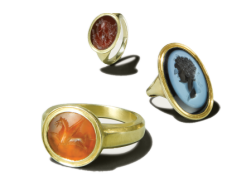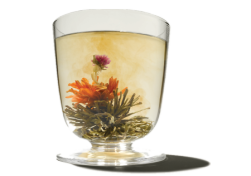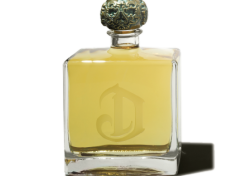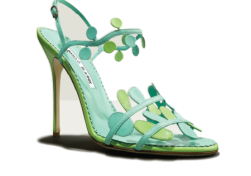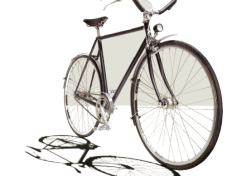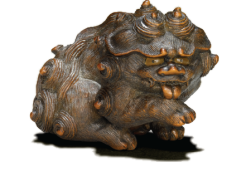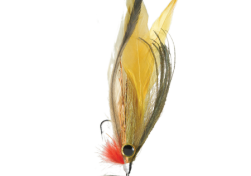When the Channel Tunnel linking Britain with France was excavated, one of the most exciting finds for archaeologists was a Roman intaglio ring. During the Roman Empire, the engraved rings would have been worn by businessmen who had images – mythological beasts, horses, portraits – carved into gems such as amethyst, agate or jasper. “In Roman times, paper didn’t last long and painting wasn’t a popular art,” says antique jewelry dealer Peter Szuhay. “So if you had a beautiful daughter, you had an intaglio made of her by the best gemcutters.” Collecting intaglios, he adds, was so popular among travelers on the Grand Tour that in the mid-18th century, most travelers to Italy came back with at least one. Today, while there has been an increased interest in the rings at auction houses such as Christie’s, with one from 330 BC selling for $118,750 last year, most are still surprisingly affordable. “People have to be educated to know the value of historical pieces,” Szuhay explains, “but most buyers have no idea what they’re looking at.” So next time you come across an old ring in less than perfect shape, it might be worth a second look. peterszuhay.com
Over the two millennia since Wang Bao first described the preparation of tea, the drink’s popularity has spread from China across the globe. Once the highly coveted drink of the rich, tea has become the world’s second-most popular drink after water. According to Cliff Burrows, the group president of Starbucks, it is not just the commonplace teabag that is being brewed. Why the resurgent popularity? Travel, says Burrows. Generation Y have journeyed to more exotic climes and heard all about tea’s health-giving properties. And, like all modern generations, they enjoy tasting new things – silver-needle iced tea, perhaps, or a cup of sparkling Golden Monkey. Last November, at Hong Kong’s first ever rare tea auction, teas more than half a century old and worth more than $1m went under the hammer. “We have had a tea-drinking tradition for a really long time,” says tea expert Vincent Chu Ying-wah. “Chinese people have got wealthy, and tea is a necessary thing. This is why the price of tea still keeps going up.” Something, no doubt, to which tea traders will raise a cup. teasenz.com
Twenty years ago, tequila was a drink associated with youthful excess: downed in shots and sandwiched between lime squeezes and salt licks. What only a few aficionados appreciated was that in small places near the town of Tequila and villages along the Tequila Route, highly purified fine liquor had been distilled for use by aristocratic families for centuries. When tequila was rediscovered by Western connoisseurs in the 1990s, it was hailed as “a spirit redolent of ripe fruits, honey and cinnamon.” Since then, the finest tequilas – made from the juice of the blue agave plant – have been introduced into some of the most respected bars in the world. Recently Sean “Diddy” Combs acquired part-ownership of boutique tequila brand DeLeón, sold in bottles made of French glass, seen here, that are as valuable as the nectar they contain. Although fashioned to appeal to Western consumers, they bears traces of the drink’s roots. “Look at the top and you will see calavera [skulls] associated with the Day of the Dead and snakes that symbolise the guarding of all that’s sacred to Mexico, including this precious juice,” says Brent Hocking, DeLeón’s CEO. deleontequila.com
When one considers the sheer beauty of a pair of stilettos by Manolo Blahnik – slithers of the finest leather, artfully constructed above an elegant heel – it is unsurprising that some women have become obsessed with them. Although high-heeled shoes have been worn since Roman times, the slimline modern heel only came into existence 60 years ago with the evolution of metal extrusion, allowing short lengths of extremely strong metal rods to be made, which cobblers realized could be used to support the foot. After seasons of vertiginous clumpy heels, the stiletto is back in force: this year many are super-sexy, such as Antonio Berardi’s Roman-style sandals, while others, like Balenciaga’s ankle-strap creations, are studded in crystals. Yet Blahnik’s designs continue to be a favorite of serious aficionados: strappy, delicately heeled and, of course, padded underfoot. “What shoes need to do is transform the way you feel,” he explains, “and to emphasise the way your buttocks move. That what makes shoes sexy. They make you feel good in your body.” manoloblahnik.com
This is the bicycle’s moment. It is the most popular means of transport on earth, with more than a billion models whizzing across the planet. There’s good reason for its renewed popularity. Ridden at low speeds of 10 to 15 miles an hour, a bicycle utilises the same amount of energy as walking. It’s cheap to run, eco-friendly, requires minimal maintenance and doesn’t get stuck in traffic jams. Today there are dozens of small new manufacturing companies, such as the Vickers Bicycle Company, which hand-builds its made-to-order Roadster, pictured right, specifically for the sophisticated urban gentleman. What their clients want, says Vickers’ founder Ian Covey, “is an elegant bike on to which they can leap, whatever they are wearing, in whatever weather, and arrive in style”. Hence this model’s elegant handlebars, which help to maintain an upright posture, and prevent suit jackets from pulling or creasing. “But then, because our bicycles are bespoke, we can make anything for anyone, no matter what their wardrobe,” he adds. “If you’re a kilt-wearer, for instance, we just remove the crossbar.”
In his poignant family memoir, Edmund de Waal describes how he inherited a collection of 264 netsukes from his great-uncle Iggie and traces their journey through generations of the Ephrussi family. “Netsukes have an extraordinary, irreducible character,” De Waal explains, “some funny, some hideous, some charming. And you can feel their stories through your fingers. I kept one in my pocket the whole time I was writing the book.” In the past, the tiny, carved Japanese figurines were not just objects of beauty, but part of a gentleman’s wardrobe: an accessory that demonstrated the wearer’s wealth, taste and social status. Because traditional kimonos had no pockets, men would suspend pouches on a silk cord passed behind their sash. The netsuke was threaded on the end to prevent the cord from slipping. As one craftsman explains, many young Japanese have little figurines hanging from their mobile phones or bags. “Although these are modern, and often commercial, the tradition is ancient. As more young people realize they can get them hand-made, the demand for traditional folkloric characters is once again rising.” rosemarybandini.co.uk
The film A River Runs Through It has a lot to answer for. When Robert Redford turned Norman Maclean’s novella into a movie starring Brad Pitt, fly-fishing graduated from a pastime for old-timers into a super-cool sport, from the rivers of Japan to the mountain streams of Aspen. Even two decades on, fly-fishing has lost none of its appeal, with increasing numbers going abroad to pursue their passion. “When it’s cold in the northern hemisphere, there’s nothing like sea fly-fishing in the Seychelles,” says Sean Clarke of Farlows, who accompanies international clients to rivers, lakes and seashores all over the world. “Or in summer, going into great wildernesses: in Canada, say, or Russia. You can helicopter into parts of Russia where there isn’t another soul for 150 miles.” This year’s cult documentary Kiss the Water tells the story of Megan Boyd, whose skill in creating such fly models as the Jock Scott and the Silver Doctor from feathers, tinsel and silk made her a revered figure among anglers, including her lifelong friend, Prince Charles. Ironically, Boyd hated the fact that her gorgeous lures were ultimately used to kill fish. farlows.co.uk
